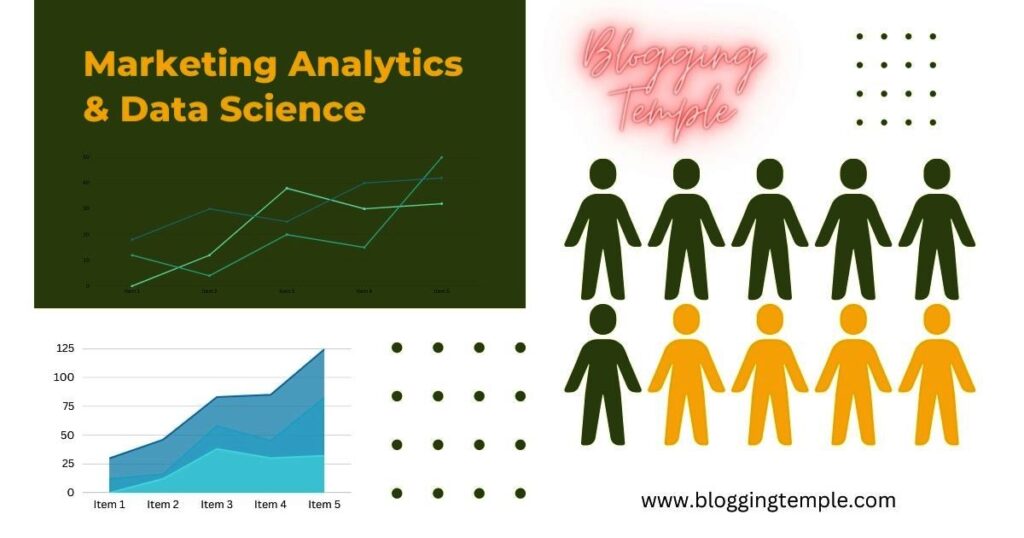In today’s data-driven world, Marketing Analytics and Data Science have emerged as crucial tools for businesses aiming to make informed marketing decisions. By harnessing the power of data, marketers can gain valuable insights into consumer behavior, optimize marketing campaigns, and drive business growth. In this article, we will explore the significance of marketing analytics and data science and how they can revolutionize your marketing strategies.
Table of Contents
Learn About Digital Marketing-https://bloggingtemple.com/what-is-digital-marketing-learn-earn/(opens in a new tab)

Objectives of Marketing Analytics and Data Science
In marketing analytics and data science, there are several key activities you can engage in to derive insights and make data-driven decisions. Here are some common tasks:
- Data collection and cleaning: Gather relevant data from various sources such as your website, social media platforms, customer databases, and marketing campaigns. Clean and prepare the data by removing duplicates, correcting errors, and ensuring consistency.
- Data exploration and visualization: Use exploratory data analysis techniques to understand the characteristics and patterns within your data. Visualize the data using charts, graphs, and other visualizations to identify trends, correlations, and outliers.
- Segmentation and targeting: Segment your customer base into distinct groups based on demographics, behaviors, or other relevant criteria. Analyze each segment’s characteristics and preferences to tailor marketing messages and campaigns for better targeting and personalization.
- Predictive modeling: Develop predictive models to forecast future outcomes such as customer churn, sales, or campaign response rates. Use techniques like regression analysis, time series analysis, or machine learning algorithms to build accurate models based on historical data.
- A/B testing: Conduct controlled experiments to compare the performance of different marketing strategies or campaigns. Split your audience into two or more groups and test variations of your marketing efforts. Analyze the results to determine which approach generates better results.
- Attribution modeling: Attribute marketing efforts to specific touchpoints along the customer journey to understand the impact of each channel or campaign. This helps you allocate resources effectively and optimize your marketing mix.
- Marketing campaign optimization: Use optimization techniques to maximize the impact of your marketing campaigns. This involves identifying the most effective combination of marketing channels, message variations, targeting strategies, and budget allocations.
- Performance measurement and reporting: Continuously monitor and measure the performance of your marketing efforts. Develop reports and dashboards that provide clear insights into key metrics and trends. Communicate the results to stakeholders and use them to inform strategic decision-making.
- Customer lifetime value (CLV) analysis: Calculate the value of a customer over their entire relationship with your business. Analyze customer behavior, purchasing patterns, and engagement levels to identify high-value customers and develop retention strategies.
- Market research and competitive analysis: Leverage data science techniques to analyze market trends, customer preferences, and competitive landscapes. Uncover insights that can guide your marketing strategies and help you stay ahead of the competition.
Remember, marketing analytics and data science are iterative processes. Continuously analyze data, test hypotheses, and refine your models and strategies based on the insights you gain. The goal is to use data to make informed decisions that drive business growth and improve marketing performance.
Understanding Marketing Analytics:
Marketing analytics involves the measurement, management, and analysis of marketing performance data to enhance decision-making and achieve marketing objectives. It encompasses various techniques such as data collection, segmentation, predictive modeling, and performance measurement. By leveraging marketing analytics, businesses can uncover patterns, trends, and correlations that provide valuable insights into customer preferences, campaign effectiveness, and return on investment (ROI).
The Role of Data Science in Marketing:
Data science involves the application of scientific methods, algorithms, and statistical models to extract knowledge and insights from large volumes of data. In the context of marketing, data science plays a pivotal role in collecting, organizing, and analyzing vast amounts of structured and unstructured data to uncover hidden patterns and predict future outcomes. It enables marketers to make data-driven decisions, personalize marketing campaigns, optimize targeting, and improve customer engagement.
Learn to Improve your knowledge: https://www.binaryeducation.in/
Key Benefits of Marketing Analytics and Data Science:
a. Enhanced Targeting and Personalization: By analyzing customer data, marketers can identify target segments, understand their preferences, and deliver personalized experiences. This leads to higher engagement, increased conversions, and improved customer satisfaction.
b. Improved Campaign Optimization: Marketing analytics and data science enable marketers to measure and evaluate the performance of marketing campaigns in real-time. This allows for timely adjustments, optimization of marketing channels, and better allocation of resources to maximize ROI.
c. Customer Journey Mapping: By analyzing data at each touchpoint of the customer journey, marketers can gain insights into customer behavior, pain points, and motivations. This helps in designing seamless customer experiences and building long-term customer relationships.
d. Predictive Analytics: Data science techniques like predictive modeling enable marketers to forecast customer behavior, anticipate trends, and make proactive marketing decisions. This empowers businesses to stay ahead of the competition and seize emerging opportunities.
e. Measuring Marketing ROI: Marketing analytics provides valuable metrics and KPIs to measure the effectiveness and efficiency of marketing initiatives. It helps in allocating marketing budgets, identifying underperforming areas, and optimizing marketing spend.

Digital Marketing Kya Hai- In Hindi https://bloggingtemple.com/digital-marketing-kya-hai-learn-earn/(opens in a new tab)
How to Do Marketing Analytics in Easy Steps:
Marketing analytics can be a powerful tool to understand your audience, measure the effectiveness of your marketing campaigns, and make data-driven decisions to improve your marketing strategies. Here are some easy steps to get started with marketing analytics:
- Define your marketing goals: Clearly define what you want to achieve with your marketing efforts. Whether it’s increasing brand awareness, generating leads, or driving sales, having specific goals will guide your analytics efforts.
- Identify key performance indicators (KPIs): Determine the metrics that align with your marketing goals. For example, if your goal is to increase website traffic, relevant KPIs could include unique visitors, page views, and referral sources.
- Set up analytics tools: Implement a web analytics tool, such as Google Analytics, on your website or marketing platforms. These tools provide valuable insights into user behavior, traffic sources, and other relevant metrics. Make sure to properly configure and integrate the tool to capture the necessary data.
- Track and measure data: Start collecting data based on your KPIs. Monitor and measure the relevant metrics regularly to gauge the performance of your marketing activities. Look for trends, patterns, and correlations in the data that can provide insights.
- Analyze and interpret data: Analyze the collected data to gain insights into your marketing efforts. Identify what is working well and what needs improvement. Look for correlations between different metrics or campaigns to understand their impact on your goals.
- Create reports and dashboards: Develop reports and dashboards to present your findings visually. Use charts, graphs, and other visualizations to communicate the data effectively. This will help you and your team understand the results and make informed decisions.
- Test and optimize: Use the insights gained from your analysis to optimize your marketing strategies. Test different approaches, campaigns, or channels and measure their impact on the desired metrics. Continuously refine your tactics based on the data you collect.
- Monitor and iterate: Marketing analytics is an ongoing process. Continuously monitor your KPIs and metrics to track progress over time. Regularly review and update your analytics approach to align with evolving goals and market dynamics.
Marketing Analytics is most effective when combined with domain expertise and a deep understanding of your target audience. It’s important to interpret the data in the context of your business goals and make strategic decisions based on the insights you gain.
Best Practices for Implementing Marketing Analytics and Data Science:
a. Define Clear Objectives: Clearly define the marketing goals and objectives you want to achieve through data-driven insights. b. Data Quality and Integration: Ensure data accuracy, consistency, and integration across various sources to get a holistic view of your marketing efforts. c. Advanced Analytics Tools: Invest in robust analytics tools and technologies that can handle large datasets, perform complex analyses, and generate actionable insights. d. Cross-Functional Collaboration: Foster collaboration between marketing, data science, and IT teams to leverage their expertise and ensure successful implementation. e. Continuous Learning and Adaptation: Stay updated with the latest trends, techniques, and algorithms in marketing analytics and data science to keep improving your strategies.
Conclusion:
Marketing analytics and data science have transformed the way businesses approach marketing. By harnessing the power of data, organizations can gain deep customer insights, optimize marketing campaigns, and drive business growth. Embracing marketing analytics and data science can provide a competitive edge, improve decision-making, and deliver personalized experiences that resonate with customers. Incorporate these practices into your marketing strategies, and unleash the true potential of data-driven marketing success.
FAQs:
1: What is marketing analytics?
Ans: Marketing analytics involves the measurement, management, and analysis of marketing performance data to enhance decision-making and achieve marketing objectives. It utilizes techniques such as data collection, segmentation, predictive modeling, and performance measurement to uncover insights into customer behavior, campaign effectiveness, and ROI.
2: How does data science contribute to marketing?
Ans: Data science plays a crucial role in marketing by applying scientific methods, algorithms, and statistical models to extract knowledge and insights from large volumes of data. It helps collect, organize, and analyze data to uncover hidden patterns, predict outcomes, personalize marketing campaigns, optimize targeting, and improve customer engagement.
3: What are the benefits of using marketing analytics and data science?
Ans: The benefits of using marketing analytics and data science include enhanced targeting and personalization, improved campaign optimization, customer journey mapping, predictive analytics for forecasting customer behavior, and measuring marketing ROI. These tools provide valuable insights to make data-driven decisions, allocate marketing budgets effectively, and build long-term customer relationships.
4: What are some best practices for implementing marketing analytics and data science?
Ans: Some best practices for implementing marketing analytics and data science include defining clear objectives, ensuring data quality and integration, investing in advanced analytics tools, fostering cross-functional collaboration between marketing, data science, and IT teams, and continuously learning and adapting to stay updated with the latest trends and techniques.
5: How can marketing analytics and data science help measure marketing ROI?
Ans: Marketing analytics provides valuable metrics and KPIs to measure the effectiveness and efficiency of marketing initiatives. It helps allocate marketing budgets, identify underperforming areas, and optimize marketing spend. Data science techniques, such as predictive modeling, can also help forecast the impact of marketing activities on revenue generation and customer acquisition.
6: What role does customer data play in marketing analytics and data science?
Ans: Customer data is essential in marketing analytics and data science as it provides insights into customer preferences, behavior, and buying patterns. Analyzing customer data allows marketers to segment their target audience, personalize marketing campaigns, understand the customer journey, and deliver better customer experiences.
7: How can marketing analytics and data science contribute to campaign optimization?
Ans: Marketing analytics and data science enable real-time measurement and evaluation of campaign performance. By analyzing data, marketers can identify successful strategies, optimize marketing channels, make timely adjustments, and allocate resources more effectively. This leads to improved campaign performance, higher ROI, and better overall marketing outcomes.
8: What are some challenges in implementing marketing analytics and data science?
Ans: Some challenges in implementing marketing analytics and data science include data quality issues, data integration from various sources, acquiring the right talent and expertise, ensuring data privacy and security, and keeping up with evolving technologies and algorithms. Overcoming these challenges requires proper planning, investment in resources, and a commitment to data-driven decision-making.
9: How can businesses use predictive analytics in marketing?
Ans: Predictive analytics, a data science technique, helps businesses forecast future outcomes based on historical data and patterns. In marketing, predictive analytics can be used to anticipate customer behavior, identify potential churn, determine the likelihood of conversions, and make proactive marketing decisions. It enables businesses to stay ahead of the competition and leverage emerging opportunities.
10: Can marketing analytics and data science benefit small businesses?
Ans: Absolutely! Marketing analytics and data science are valuable for businesses of all sizes. Small businesses can leverage these tools to gain insights into their target audience, optimize marketing efforts on a limited budget, and make data-driven decisions that lead to better customer engagement, improved ROI, and business growth.


0 thoughts on “Marketing Analytics and Data Science- An Unleashing the Power | A Dynamic Startup in 21st Century”